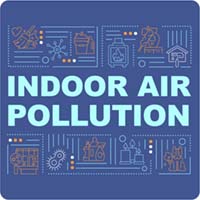
More Articles

The topic of Indoor Air Quality (IAQ) can be a bit confusing and complex. Over the years it has been riddled with opinions, faddish hysteria, sensational headlines, personal injury lawyers, black molds, toxins, legionnaires disease, misconceptions and sometimes blatantly false information. We’ve seen a meteoric rise in the number of IAQ “experts” and professionals followed by an equally dramatic disappearance of the same experts. “The air in your house is 70% worse than outside!”, “Put an air purifier in every room!”, “The hidden silent killers in your home’s air!”, “Sanitize everything!” The actual data has gotten lost in a sea of looniness.

Let's simplify things, shall we?
First of all, what exactly is IAQ? Indoor Air Quality is nothing more than the properties and characteristics of the air within a structure or enclosed space. The term IAQ generally refers to how healthy the air is to occupants. That’s it. The list of factors that can degrade the quality of the air is almost endless and overwhelming, so rather than focusing on what makes bad Indoor Air Quality, it might be more fruitful to get an idea of what makes good or ideal air quality.

Good IAQ for human occupation would have the following characteristics:
- First, good IAQ will have breathable air with a healthy balance of oxygen and other gases for occupants. But without fancy sensors and meters how would you tell whether the oxygen is at the ideal concentration of 21%?Oddly enough, the indications of improper balance are usually not because of lack of oxygen, but more often a result of too much CO2, Carbon Dioxide. One will notice a certain lethargy, tiredness or reduced ability to mentally focus. Most commercial buildings have a requirement to provide a certain amount of outside air during the operation of the HVAC system. Adjusting the controls to increase the outside air will usually alleviate the situation if there has been an increase in CO2 levels. Most homes do not necessarily have outside air vents, but have a much more effective solution - open a window or door!
- The humidity level in a healthy IAQ environment will be reasonable. Generally, people are most comfortable when the relative humidity is somewhere between 40 and 60%. This, of course, varies somewhat as people adapt to different climates, but as a rule, if the humidity is much lower or higher, a person will experience definite physical impacts.
 Low humidity leads to dry skin, dry hair and chapped lips. Mucous membranes in nose and throat dry out, causing discomfort and irritation. A person will have a greater chance of getting colds and respiratory illnesses. Additionally, body moisture evaporates so quickly that one can feel cold even at warmer temperatures.High humidity, on the other hand, has a host of ill effects both to the body as well as to the home or building. Things you may notice that would likely be the result of humidity that is too high could include: allergic reations, clammy or oily skin, and even an inability for the body to naturally cool itself.The symptoms of high humidity usually are more noticeable in the building itself. condensation on windows and metal fixtures, stains on the walls, pervasive musty odors, a clammy feel to the air. One may observe rotten building components (which is a sure indication that the problem has been around for awhile!). There may be an unusual increase in insects inside. Mold may become evident in parts of the structure. Any of these things will degrade the quality of the air and can trigger negative physiological reactions.
Low humidity leads to dry skin, dry hair and chapped lips. Mucous membranes in nose and throat dry out, causing discomfort and irritation. A person will have a greater chance of getting colds and respiratory illnesses. Additionally, body moisture evaporates so quickly that one can feel cold even at warmer temperatures.High humidity, on the other hand, has a host of ill effects both to the body as well as to the home or building. Things you may notice that would likely be the result of humidity that is too high could include: allergic reations, clammy or oily skin, and even an inability for the body to naturally cool itself.The symptoms of high humidity usually are more noticeable in the building itself. condensation on windows and metal fixtures, stains on the walls, pervasive musty odors, a clammy feel to the air. One may observe rotten building components (which is a sure indication that the problem has been around for awhile!). There may be an unusual increase in insects inside. Mold may become evident in parts of the structure. Any of these things will degrade the quality of the air and can trigger negative physiological reactions. What to do? First, when there are indications, compare the inside air to the outside air. If it's highly humid or arid outside as well as inside, it could simply be the climate, but if the difference is noticeable, find the source and take steps to fix it. For instance, if there is a lot of humidity inside, but not outside the home, there may be a leak in the irrigations system, a broken pipe or clogged drain. There could be a roof leak or water pooling under the house. A home that is too tightly sealed can lead to excessive humidity. Open some windows! In any case, find the source. Some solutions will be as simple as opening a window, others may involve more complex solutions. But either way, high humidity issues should be addressed effectively.
What to do? First, when there are indications, compare the inside air to the outside air. If it's highly humid or arid outside as well as inside, it could simply be the climate, but if the difference is noticeable, find the source and take steps to fix it. For instance, if there is a lot of humidity inside, but not outside the home, there may be a leak in the irrigations system, a broken pipe or clogged drain. There could be a roof leak or water pooling under the house. A home that is too tightly sealed can lead to excessive humidity. Open some windows! In any case, find the source. Some solutions will be as simple as opening a window, others may involve more complex solutions. But either way, high humidity issues should be addressed effectively. - Another characteristic of a good indoor air quality environment is that the temperature is at a comfortable and healthy level. Again, this is something that is subjective and is effected greatly by climate and how accustomed a person is to varying temperatures, high or low. However, the temperature is comfortable or not. If it isn't take the necessary or feasible steps to remedy things. Have the heating and air conditioning systems serviced regularly, ensure the thermostats are working right, check for any leaks or disconnections in the duct systems.
- The atmosphere in a good IAQ environment is free of excessive dust and debris.
 Once again, compare the indoor environment to the air outside. Is there a freeway right next door? How about a construction site or other dust generating activity, whether man-made or natural. We've experienced numerous fires in Southern California and for months afterward continued to find soot in the carpet, walls and furnishings. If any of these do exist, added filtration may be needed on the A/C system, install an air scrubber inside the home, get the project completed if it's some construction going on in the home itself.But very often, it is simply a matter of more diligent housekeeping. A building does not clean itself. It just takes work and some areas may require cleaning more often than others. Cleaning is good for the indoor air quality.
Once again, compare the indoor environment to the air outside. Is there a freeway right next door? How about a construction site or other dust generating activity, whether man-made or natural. We've experienced numerous fires in Southern California and for months afterward continued to find soot in the carpet, walls and furnishings. If any of these do exist, added filtration may be needed on the A/C system, install an air scrubber inside the home, get the project completed if it's some construction going on in the home itself.But very often, it is simply a matter of more diligent housekeeping. A building does not clean itself. It just takes work and some areas may require cleaning more often than others. Cleaning is good for the indoor air quality. - The air is free of unpleasant or irritating odors. Odors can have many sources and many implications, so when an unusual or bad odor is noticed, one should use his or her nose to follow the trail to the source because there will always be a source!
 As always, the first thing to do is compare the smell inside to the smell outside the home. It could be as obvious as some road paving being done, so there will be a tar smell, or the neighbor just fertilized his lawn, so there is the manure smell. As unpleasant as these may be, you can be assured that the remedy is a little time. Honestly, the majority of odors can be traced to the source rather readily and the problem addressed in a straight forward way. Other situations may be more involved where the source is not so easily found. In these cases, one may need to hire a professional or a consultant to assist. Whatever the case, however, one should not ignore bad odors. Most of the time, you'll find it isn't dangerous, but other times, it could be something quite toxic or unhealthy. The one thing for sure, though is that ignoring it will never solve it.
As always, the first thing to do is compare the smell inside to the smell outside the home. It could be as obvious as some road paving being done, so there will be a tar smell, or the neighbor just fertilized his lawn, so there is the manure smell. As unpleasant as these may be, you can be assured that the remedy is a little time. Honestly, the majority of odors can be traced to the source rather readily and the problem addressed in a straight forward way. Other situations may be more involved where the source is not so easily found. In these cases, one may need to hire a professional or a consultant to assist. Whatever the case, however, one should not ignore bad odors. Most of the time, you'll find it isn't dangerous, but other times, it could be something quite toxic or unhealthy. The one thing for sure, though is that ignoring it will never solve it. - The final major component to an environment with good IAQ is that the air is free of toxins, dangerous compounds or allergins. Many of these things are odorless such as carbon monoxide, radon and some molds and bacteria. Others are very evident, such as Volitile Organic Compounds (VOCs), the "new carpet smell" or new furniture smell. Those odors actually come from formaldehyde used to help preserve fabrics, plastics and the like. New clothes will typically have formaldehyde. Time is the only cure for that odor. But others are more harmful and need to be addressed. Household chemicals are notorious for their negative impact on human bodies.
Toxins are a little more tricky because of the variation and the fact that many have no odors or other visible evidence. One may feel "off" at an office, get headaches or have a funny taste in one's mouth. The symptoms could be wild and many.Check for and dispose of toxic chemicals or at least ensure they are stored securely and properly. Change from chemical laden cleaners to more eco-friendly cleaners, inspect gas lines for leaks, ensure the batteries are fresh in the CO2 monitors if you have them. Go through the building or house, find and handle potential sources of toxic items. For instance, old, ratty dirty carpet can harbor some nasty molds. Get it cleaned more often, or consider removing it for hardwood or tile flooring. Look for evidence of water damage which can create a good breeding ground for toxic molds and bacteria.
IAQ problems are no reason to become frantic. But they are also not to be shuffled aside. Most issues are easy to track down and have straight forward logical solutions. And the easiest way we have found to locate the sources is to compare what one sees or observes inside a building to what is outside the building, then compare what the air is like to what "good IAQ" is as described above. That will get one pointed in the right direction to disover the source and then work out a solution. When the above basic steps are taken and symptoms continue to be experienced, it is time to engage a professional to do some more in-depth investigation and testing and find the source.



Until next time!






